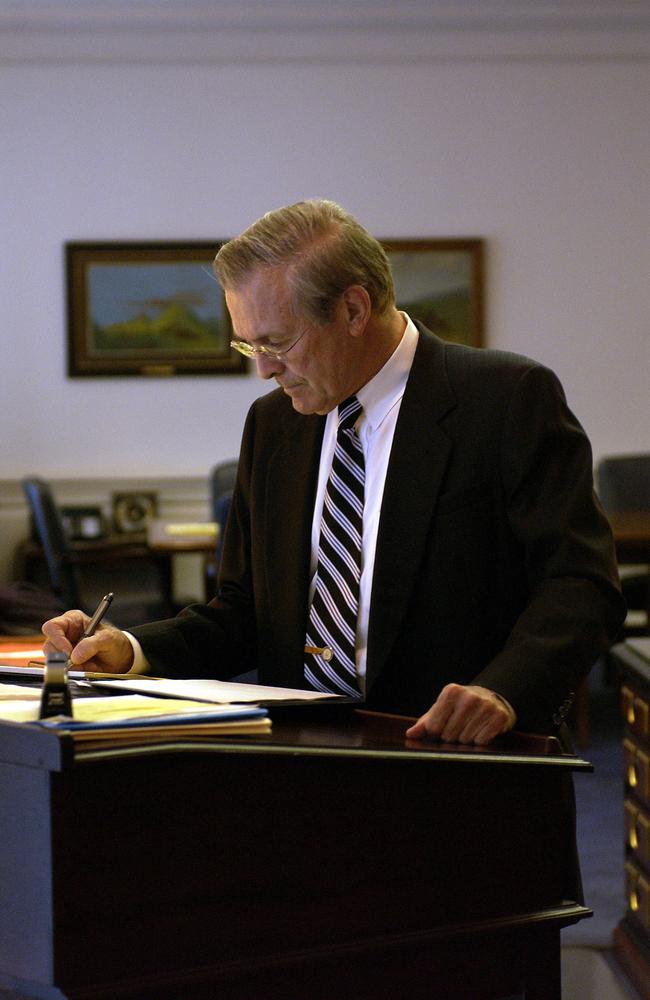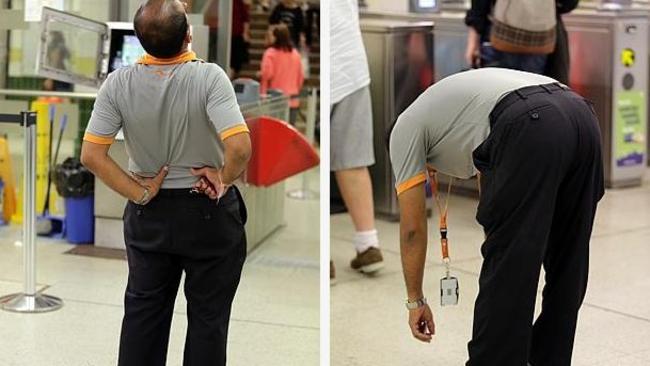Standing is the new sitting, and it’s even the new cancer if you believe the Apple CEO. Do YOU stand at work?
STAND up, take notice. Sitting is really bad for you. Everyone from Tim Cook to Donald Rumsfeld is standing up — and it’s changing their lives.

KNOW why scarecrows are so excellent? Because they’re always outstanding in their field.
Apologies for starting this story with a dad joke, but this is a tale about some truly outstanding people. Who? All of us, that’s who.
Across Australia and indeed much of the world, people are standing at work to perform tasks they used to do sitting down. Especially in meetings, chairs are so 2012.
Speaking at a conference last week, Apple chief Tim Cook said “sitting is the new cancer”. His wording was a little dramatic, and he happened to be spruiking a new $350 Apple watch which vibrates to remind him to go walk around, but the 54-year-old CEO made a fair point. Sitting is bad for us. Which we all kind of suspected anyway, but never did much about. Until recently.
Donald Rumsfeld, Secretary Of Defense from 2001 to 2006 in the George W Bush administration, was perhaps the first widely publicised desk-stander. Standing at your desk like Rumsfeld has since been proven to be good for everything from your posture to your weight, to the prevention of more serious conditions like diabetes and heart disease.

But standing at your desk, or even walking on a desk treadmill (yep, they’re a thing) doesn’t just improve your health. It can even make you smarter, says a new study.
The study basically got people walking on a treadmill while performing some basic cognitive tasks to see if they think better while walking. Their conclusion? You bet they do. “Participants … improved their cognitive performance when walking at their preferred speed as opposed to sitting …” the study concluded.
We all know intuitively that even just the act of getting up from your desk can spur a light bulb moment, or even just make us feel re-energised about the task at hand. As for meetings, the act of being on our feet performing makes you more attentive, more energised and less likely to waste words.

As one manager we spoke to said: “If you book a room for half an hour with people sitting around a table, you’ll use up the whole half-hour. Have that same meeting standing and you’ll be done in 10 minutes”.
The standing trend probably won’t be going anywhere for a while. But can standing ever be a bad thing? That’s how the ticket barrier attendants at Sydney’s trains saw things recently when management took away their seats. For eight hours, the workers are forced to perform a relatively mundane task which you would have thought could be done just as efficiently sitting down.
Union reps claimed it was worse than Guantánamo Bay, the notorious US Military Prison where prisoners were tortured with a variety of cruel methods, including “the use of stress positions (like standing), for a maximum of four hours”.
Workers we spoke to weren’t quite that traumatised, but they did said they hated having no chairs. Interestingly, they also noted it was harder to maintain concentration after an hour or so than previously when they were allowed to sit.

Sydney Trains claim the no-chair policy has delivered an improved level of customer service, but this daily train commuter user can’t say he’s noticed one way or the other. Meanwhile, it remains unclear whether the executives issuing the no-chair edict have themselves done away with their comfortable seats. But we strongly doubt it.

Well, where do you, ahem, stand on this issue? Do you stand for meetings at work or are you a sitting person? Let us know in the comments below.



